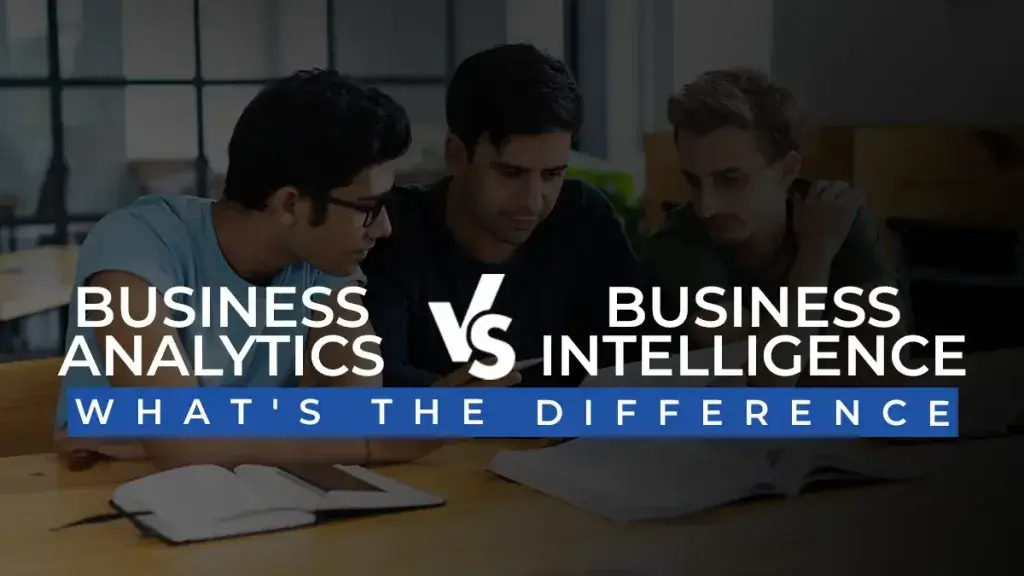Business analytics vs business intelligence – What’s The Difference

Here's What We've Covered!
In today’s data-driven business world, two terms often pop up during discussions: Business Analytics and Business Intelligence. But what do these terms really mean and why is it important to know the difference between them?
Well, Business Analytics is like a detective that helps businesses discover hidden patterns and trends in data to make informed decisions. On the other hand, Business Intelligence is more like a storyteller which involves presenting information clearly and understandably to support decision-making processes. This involves collecting, organizing, and visualizing data to provide actionable insights for stakeholders.
Therefore learning about the differences between Business Analytics and Business Intelligence is extremely important because they both offer different purposes and require different approaches to analyze data. So if you’re someone interested in exploring these two terms then get ready because, in this blog, we’ll discuss the distinctions between these two concepts and analyze how each of them contributes to improving decision-making processes and driving business growth.
Understanding Business Intelligence (BI)
Business Intelligence which is often called BI for short helps businesses look into the past and present to make smarter decisions for the future. The most important purpose of BI is to gather, organize, and analyze data from various sources in order to provide valuable insights that affect business strategies.
In simple words, BI looks at Historical Data Analysis. You must be wondering what are the tools and technologies used for Business Intelligence. Well, BI relies on a range of tools and technologies to do its magic. These tools can include software like Microsoft Power BI, Tableau, or Google Data Studio.
Let’s have a look at examples of BI Application
- Flipkart’s Sales Optimization: Flipkart is considered one of India’s largest e-commerce platforms. It utilizes Business Intelligence to optimize its sales strategies. By using BI tools like Microsoft Power BI and Oracle BI, Flipkart studies its customer behavior, purchase patterns, and product preferences. This allows them to personalize recommendations, target promotions effectively, and streamline inventory management. Therefore by using BI tools effectively, Flipkart tries to improve its customer satisfaction, boost sales, and maintain its competitive position in the market.
Delving into Business Analytics (BA)
Business Analytics is like a detective for businesses that helps them solve dilemmas hidden in data to make better decisions. It involves collecting and analyzing data from different sources to understand what’s happening in a business and why. The scope of BA is broad, covering everything from sales and marketing to finance and operations.
BA puts a lot of focus on predicting the future and suggesting actions to take. Predictive analysis uses data to forecast what might happen next, like predicting customer behavior or sales trends. Prescriptive analysis goes a step further, recommending the best course of action based on those predictions, such as which marketing strategy to use or how to optimize production processes. BA uses various techniques and methods to uncover insights from data. This includes statistical analysis, data mining, Machine learning, etc.
An example of BA Applications is:
- Reliance Jio: Reliance Jio uses BA to analyze customer usage patterns and preferences. By examining data on call volumes, internet usage, and customer demographics, Jio can improve its services and marketing strategies to better meet customer needs.
Differentiating Between Business Intelligence and Business Analytics
In the previous sections, we have discussed about business intelligence and business analytics separately. Now in this section let’s compare these two terms to get a better grasp of what they mean.
| Aspect | BI | BA |
| Primary Objective |
|
|
| Technologies and Tools |
|
|
| Time Horizon |
|
|
| Data Focus |
|
|
| Decision-Making Support |
|
|
| User Base and Applications |
|
|
After learning about BA and BI, you might be interested in exploring more about these fields, right? Well, if you’re still deciding where to pursue Business Analytics then don’t worry! You can check out the Business Analytics course offered by IMS Proschool. Their well-structured Business Analytics course is taught by experts who have graduated from top institutions like IIMs and IITs. By joining their institution which is available across 10+cities in India you can access over 800 job opportunities and expect to earn an average salary between 3 to 9 LPA.
By enrolling in this course you can start your journey in the exciting field of analytics!
Also Read – Top 15 Interview Questions For Tableau To Crack Your Next Interview
Use Cases and Benefits
-
Business Intelligence Use Cases and Benefits:
Business Intelligence (BI) is like a magic mirror for businesses as it reflects past and present data to guide decision-making. Some common BI use cases include:
- Sales and Marketing Optimization: BI helps companies analyze customer behavior, sales trends, and marketing effectiveness to optimize sales strategies and maximize revenue.
- Operational Efficiency: BI tools can track key performance indicators (KPIs) and operational metrics that help businesses identify inefficiencies, streamline processes, and reduce costs.
- Customer Relationship Management (CRM): BI improves the CRM systems by providing insights into customer preferences, purchasing patterns, and satisfaction levels and allows businesses to personalize interactions and improve customer retention.
-
Business Analytics Use Cases and Benefits:
Business Analytics (BA) takes BI a step further by using advanced techniques to predict future trends and prescribe actions. Here are some BA use cases:
- Predictive Analytics: BA predicts future outcomes based on historical data and helps businesses anticipate market trends, customer behavior, and demand fluctuations.
- Risk Management: BA identifies potential risks and opportunities by studying the data from various sources and helps businesses make informed decisions to mitigate risks and capitalize on potential opportunities.
- Supply Chain Optimization: BA optimizes supply chain operations by forecasting demand, identifying bottlenecks, and optimizing inventory levels, ensuring efficient resource allocation and timely delivery.
Also Read – Top 12 Skills Every Business Analyst Should Possess
-
Combined Applications for Comprehensive Insights:
By combining BI and BA, businesses can gain comprehensive insights into their operations, customers, and markets. This integrated approach allows for:
- Holistic Decision-Making: Combining BI’s descriptive insights with BA’s predictive and prescriptive capabilities enables businesses to make informed decisions that drive growth and innovation.
- Enhanced Strategic Planning: By leveraging both BI and BA, businesses can develop strategic plans that are grounded in data-driven insights, increasing agility and competitiveness in the market.
- Continuous Improvement: Integrating BI and BA facilitates continuous improvement initiatives by providing real-time feedback, enabling businesses to adapt quickly to changing market conditions and customer preferences.
Let’s look at a practical example:
SpiceJet which is a prominent airline in India combines BI and BA to increase its revenue management strategies. Through BI tools, SpiceJet studies its historical booking data, passenger preferences, and competitor pricing strategies to develop pricing models and promotional offers. Also, SpiceJet operates BA techniques such as predictive analytics to forecast passenger demand, optimize seat inventory, and even maximize their revenue yield on flights.
Therefore it is clear from this section that, BI and BA offer valuable tools for businesses to gain insights, optimize operations, and drive growth. Whether used individually or in combination, these tools entrust businesses to make smarter decisions and stay ahead in the industry.
Wow, combining BI and BA can offer so much value to businesses, right?
No wonder business analytics is such a sought-after skill these days! But it’s only really useful if you learn it from highly qualified and experienced professionals from well-known institutions. That’s why you should check out the Business Analytics course offered by IMS Proschool. Wondering why? Here’s why:
- Learn Top Analytics Tools: You can get a chance to gain expertise in popular business analytics tools like Excel, SQL, Tableau, Power BI, and Python.
- Learn From Analytics Experts: Their Business Analytics instructors have over 30 years of combined industry experience. Plus, you can get help with your questions 24/7.
- Active Learning Approach: They offer a unique teaching method that involves case studies, practical exercises, and group work. This ensures that students are engaged and motivated alongside like-minded peers.
- Problem-Solving Skills: You get to acquire techniques to effectively identify, analyze, and solve business challenges.
- Start From Basics: Whether you’re new to coding or feel like you’re not tech-savvy enough, don’t worry! Their Business Analytics course starts from the basics, making it accessible to everyone.
Well, if the previous points didn’t convince you enough, then you should also know that graduates of IMS Proschool’s Business Analytics course are now working in top companies like Standard Chartered, Tata Consultancy Services, Accenture, Deutsche Bank, Hindustan Times, and many more.
So you can also be molded to become one of them within just 4 months!
Also Read – Understanding the Key Differences Between Data Analytics and Business Analytics
Challenges and Considerations
Anything that provides a lot of benefits usually comes with some challenges and things to think about. The same goes for BI and BA. So in this section, let’s take a closer look at them and explore them further.
-
Data Quality and Integration:
- One of the major challenges businesses face in implementing Business Intelligence (BI) and Business Analytics (BA) solutions is ensuring the quality and integration of data.
- Companies often deal with disparate data sources, varying formats, and inconsistencies in data quality that can hinder accurate analysis and decision-making.
- Indian companies like Infosys and TCS have tackled this challenge by investing in powerful data management systems and data integration tools.
- They ensure data quality through rigorous data validation processes and data governance frameworks, ensuring that insights derived from BI and BA initiatives are reliable and actionable.
-
Skill Set and Expertise Requirements:
- Interpreting complex data sets and cracking insights demand a blend of technical and domain-specific knowledge.
- Indian firms such as Wipro and Genpact mitigate this challenge by offering extensive training programs and upskilling initiatives for their workforce.
- By cultivating a talent pool proficient in data analysis, statistical modeling, and data visualization, they authorize employees to use BI and BA solutions effectively.
-
Cost and Implementation Complexity:
- Implementing BI and BA solutions can be a costly and complex process for businesses, especially for small and medium enterprises (SMEs).
- The investment required in software licenses, hardware infrastructure, and skilled personnel can pose financial challenges.
- Companies like HCL Technologies and Tech Mahindra offer customized BI and BA solutions made to the budget and requirements of SMEs. They offer cloud-based platforms and scalable technologies to minimize upfront costs and simplify implementation, making BI and BA accessible to a wider range of businesses.
-
Organizational Alignment and Culture:
- Organizational alignment and culture play a crucial role in the successful adoption of BI and BA initiatives.
- Resistance to change, lack of buy-in from stakeholders, and siloed organizational structures can hinder this progress.
- By encouraging cross-departmental collaboration, establishing transparent communication channels, and incentivizing data-driven behaviors, companies can operate BI and BA initiatives in the organizational DNA.
No matter what challenges you face in any organization, with the right skills and training, you can overcome them eventually. However, acquiring those skills in the first place requires rigorous training and learning from industry experts who are dealing with those challenges on a regular basis.
That’s why you should consider checking out the Business Analytics course offered by IMS Proschool. Their faculty consists of top experts from the country, and their course is extremely well structured and comprehensive and covers everything that you would need for a career as an analyst. In fact, their USP is also that they offer the option to learn Financial Analytics through their 6-month-long Financial Analytics course, which includes primary markets and BFSI Analytics. Moreover, they aim to provide a pathway to PGCM-FA (AICTE approved), which can create more opportunities for you in the future.
Also Read – Top 8 Tools Every Business Analyst Should Use In 2025 To Solve Problems
Conclusion
In conclusion, Business Intelligence (BI) and Business Analytics (BA) each present unique insights into business data, and together, they form a powerful duo, with BI providing a foundation of understanding and BA offering predictive capabilities for informed decision-making. Businesses are encouraged to make use of both BI and BA to gain a thorough understanding of their operations, customers, and markets.
In fact, for those of you who are interested in digging into the field of business analytics and BI further and are considering a specialized analytics course offered by a reputable institute then make sure to check out the Business Analytics course offered by IMS Proschool. This course provides the practical skills and expertise needed to succeed in data analytics and business intelligence by certifying individuals to make meaningful contributions to their organizations.
FAQs
-
Is analytics a business intelligence?
Yes, analytics is a subset of business intelligence (BI). Business intelligence encompasses various data management solutions, including business analytics and data analytics. These subsets are utilized to comprehend historical and current data and derive insights for informed decision-making within organizations.
-
What do business analysts do?
Business analysts work with data to understand how a business operates and suggest improvements. They can find problems in different areas of a company, like its computer systems, how it’s organized, or how employees are trained.
-
Does AI belong to business analytics?
AI tools help your business analysts get a better understanding of your business much quicker than doing everything by hand. Since AI algorithms use data that are updated in real time, analysts can spot and fix unusual things happening in the business faster.
-
What’s ahead for business analytics in the future?
The future of business analytics looks promising as more companies depend on data insights and new methods like machine learning to improve results.
-
What are the 4 main ideas of business intelligence?
Business intelligence (BI) revolves around four essential concepts: data collection, analysis, visualization, and decision-making. Data collection means gathering important information from different sources. Analysis uses tools and methods to understand insights and trends from the collected data.
Resent Post
>
Emerging commerce career options in India (2026): From CA to Data Analyst
>
ACCA Opportunities You Didn’t Know About – Think Beyond Audit!
>
Which Courses After 12th Commerce With High Salary Are in Demand Worldwide?
>
How to Find ACCA Jobs Online After Qualifying: Real Portals, Tips & Career Guidance
>
Financial Modelling Classes in Hyderabad: Your Guide to the Best Institutes
Follow Us For All Updates!



